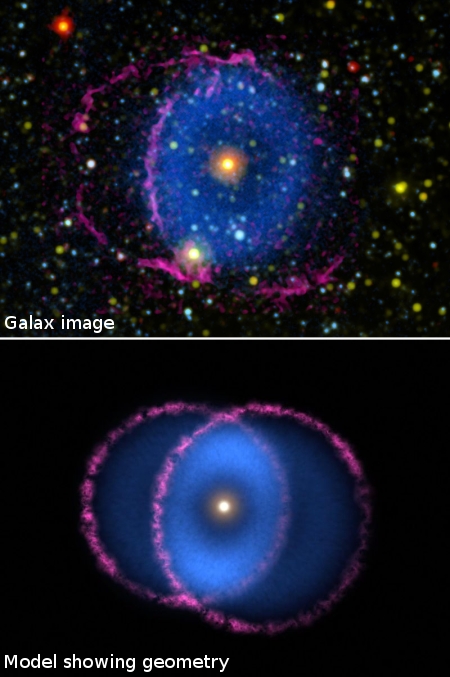New model suggests ringed nebula caused by star merger
Based on a new theoretical model, astronomers now believe that the Blue Ring Nebula, a planetary nebula discovered in 2004 by the Galaxy Evolution Explorer (GALEX), was the result of the merger of two stars that only occurred a few thousand years earlier.
The image to the right, cropped, reduced, and annotated to post here, shows the original GALEX image on top, with a model to illustrate the geometry. The nebula is shaped like an hour-glass, with the rings the wide parts at the top and bottom. We just happen to be looking at it along its axis.
A new study published online on Nov. 18 in the journal Nature may have cracked the case. By applying cutting-edge theoretical models to the slew of data that has been collected on this object, the authors posit the nebula – a cloud of gas in space – is likely composed of debris from two stars that collided and merged into a single star.
While merged star systems are thought to be fairly common, they are nearly impossible to study immediately after they form because they’re obscured by debris the collision kicks up. Once the debris has cleared – at least hundreds of thousands of years later – they’re challenging to identify because they resemble non-merged stars. The Blue Ring Nebula appears to be the missing link: Astronomers are seeing the star system only a few thousand years after the merger, when evidence of the union is still plentiful. It appears to be the first known example of a merged star system at this stage.
When the merger happened it caused the bi-polar jets that formed the hourglass shape.
Based on a new theoretical model, astronomers now believe that the Blue Ring Nebula, a planetary nebula discovered in 2004 by the Galaxy Evolution Explorer (GALEX), was the result of the merger of two stars that only occurred a few thousand years earlier.
The image to the right, cropped, reduced, and annotated to post here, shows the original GALEX image on top, with a model to illustrate the geometry. The nebula is shaped like an hour-glass, with the rings the wide parts at the top and bottom. We just happen to be looking at it along its axis.
A new study published online on Nov. 18 in the journal Nature may have cracked the case. By applying cutting-edge theoretical models to the slew of data that has been collected on this object, the authors posit the nebula – a cloud of gas in space – is likely composed of debris from two stars that collided and merged into a single star.
While merged star systems are thought to be fairly common, they are nearly impossible to study immediately after they form because they’re obscured by debris the collision kicks up. Once the debris has cleared – at least hundreds of thousands of years later – they’re challenging to identify because they resemble non-merged stars. The Blue Ring Nebula appears to be the missing link: Astronomers are seeing the star system only a few thousand years after the merger, when evidence of the union is still plentiful. It appears to be the first known example of a merged star system at this stage.
When the merger happened it caused the bi-polar jets that formed the hourglass shape.

